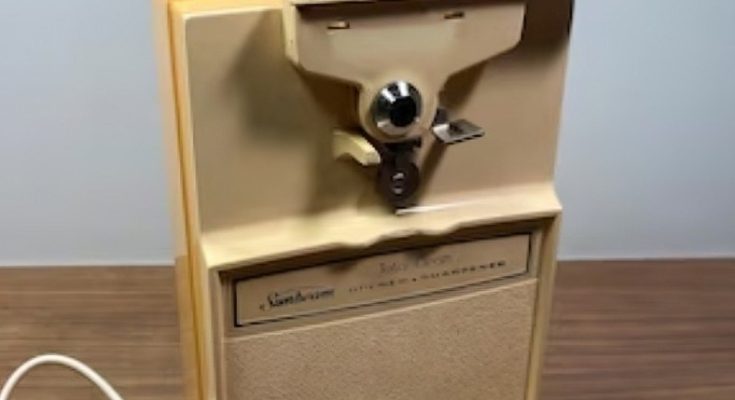The Need for Can Openers: Solving a Problem
The idea of preserving food in tin cans first started in the Netherlands in 1772. Back then, cans were made with thick, sturdy walls and sealed with a heavy metal lid. Although canned food was a breakthrough in food preservation, consumers had one big problem: getting the food out of the can!
In the early days, people would use anything from knives to hammers and chisels to open cans. This method was not only dangerous but also highly inconvenient. It became clear that a specialized tool was needed to open cans safely and efficiently, leading to the invention of the first can openers in the mid-19th century.
The First Can Opener Designs
The first patent for a can opener was issued in 1855 by an English inventor, followed by a U.S. patent in 1858. These early designs were very basic and resembled knives. They had slightly sharpened edges, which allowed users to pry open the lids with some difficulty. While these designs were innovative at the time, they were far from user-friendly and required considerable strength and effort.
The Cutting Wheel Breakthrough (1870)
A major step forward in the evolution of the can opener came in 1870 with the introduction of the cutting wheel. This rotating wheel allowed users to clamp the tool onto the can and cut around the edge in a circular motion. Though this design was an improvement, it still required precision and strength, which limited its popularity. Many people found the cutting wheel challenging to use.
A Game-Changing Innovation: The Serrated Wheel (1925)
The can opener saw a revolutionary improvement in 1925 with the addition of a serrated wheel. This new design featured a second wheel that worked in tandem with the cutting wheel, providing more stability. The serrated wheel gripped the rim of the can while the cutting wheel sliced through the lid, making the can opener much easier to use. This design quickly became a household staple and is still one of the most recognized models today.
The two-wheel can opener allowed people to open cans with ease, making meal prep faster and more convenient. Its simple yet effective design is still used in kitchens around the world.
Military Can Openers: The P-38 and P-51
World War II brought new innovations in can opener technology. During the war, the U.S. military developed compact, portable can openers for soldiers. The P-38 and P-51 models were small, foldable tools designed for easy use in the field. Soldiers could carry them in their gear and quickly open cans during combat.
These military-grade can openers became popular not only with soldiers but also with outdoor enthusiasts. Hikers, campers, and survivalists appreciated the durability and convenience of these compact tools, which are still used by some today.
The Rise of Electric Can Openers
The late 1950s introduced a new era in can opener technology with the advent of electric models. These can openers removed the need for manual effort, making them especially popular with people who had limited hand strength or mobility. With the push of a button, the electric can opener would do all the work, revolutionizing how people opened cans.
Electric models quickly became household favorites, and manufacturers added features like magnetic lid holders and automatic shut-off for extra convenience. Electric can openers remain a popular choice in many kitchens today.
The Modern Twist: Side-Cutting Can Openers
In recent years, the side-cutting can opener has gained popularity among safety-conscious consumers. Instead of cutting through the top of the can, these models slice through the side, leaving a smooth edge on both the can and the lid. This reduces the risk of cuts and allows the lid to be placed back on the can, helping to preserve leftover food.
Side-cutting can openers are valued for their safety and practicality, making them a popular choice in modern kitchens.
Conclusion: From Basic Tools to Kitchen Essentials
The evolution of the can opener reflects society’s constant drive for convenience and efficiency. From the earliest crude designs to modern electric and side-cutting models, each version of the can opener has introduced new features that have made it easier, safer, and faster to use.
Whether you prefer a classic manual opener, a military-grade tool, or the latest electric model, one thing is clear: the can opener has come a long way. As technology continues to evolve, who knows what future innovations this essential kitchen gadget might bring?



